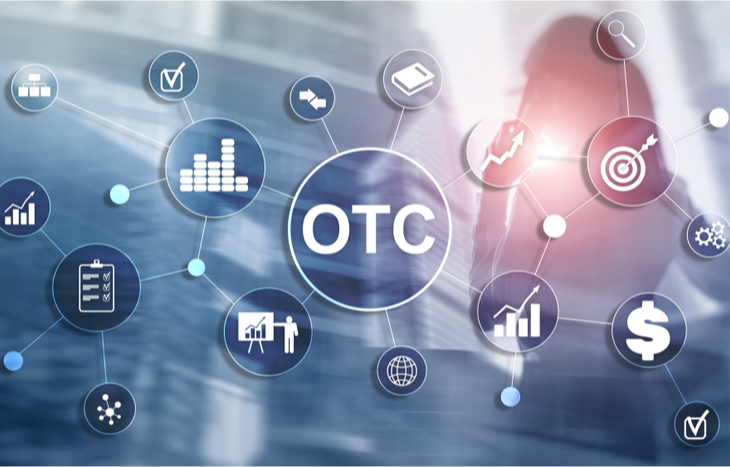How Does the OTC Market Work?
Over-the-counter (OTC) markets make up a significant amount of the trade volume outside of traditional exchanges. It’s within the OTC market that unlisted securities change hands and derivatives originate. Sometimes called “pink sheet securities” or “off-board exchanges,” these trades happen directly between those selling and those buying. This broker–dealer network setup is highly liquid and very accessible.
OTC markets tend to get a bad rap due to penny stocks and pump-and-dump schemes. That said, there are plenty of opportunities to trade securities from reputable companies in OTC markets. Moreover, many unlisted securities eventually get listed. The most famous example is Walmart (NYSE: WMT), which first traded OTC in 1972.
More than a place for penny stocks and fallen companies, OTC markets represent international organizations, up-and-coming companies, venture businesses and more, including derivatives.

What Is an OTC Market?
As its name implies, an over-the-counter market is a direct one. Instead of taking place through exchanges, buying and selling happens in a broker–dealer market. This isn’t a free-for-all, however; the Financial Industry Regulatory Authority (FINRA) governs the OTC market. It’s a space for securities and financial products that don’t meet exchange listing criteria.
Companies list on OTC markets for many reasons. The most common is cost – it costs $500,000 to list on the NYSE and up to $75,000 to list on the Nasdaq. Fledgling companies and venture startups need to raise capital, so they list OTC to avoid taking on this debt. Another reason is exchange restrictions. For example, foreign companies may not meet SEC disclosures before listing. The OTC market gives retail and institutional investors access to these products outside of exchanges.
Types of OTC Products
The scope of OTC products is wide and diverse. Because there aren’t exchange-listing requirements or specific barriers to entry, an eclectic range of financial products are prevalent. It all depends on who’s selling and who’s buying!
- Equities: There are a broad range of stocks available OTC. Most of them represent companies too small to list on a major exchange or foreign companies that don’t meet listing requirements. While there are some junk securities and penny stocks, the broad scope of OTC equities represent viable companies.
- Debt Instruments: Most bonds come available through OTC markets because they’re a direct issuance by the company or a government entity. For example, U.S. Treasury bonds –arguably the most secure investment around – are OTC, bought directly from the government. Investment-grade bonds are OTC products. Unfortunately, so are many junk bonds.
- Derivatives: Derivatives trade OTC because they’re not tangible financial instruments. Rather, they are speculations about underlying assets. By nature, these investments don’t occur on an exchange (there’s nothing exchanged).
These off-exchange products and many others represent accessible investment opportunities. For example, a person may choose to invest in a Japanese company not listed on the NYSE or Nasdaq, as a hedge against U.S. economic turbulence. Moreover, these products provide access to things like T-bills, which offer much safer investment prospects.
How to Buy, Sell and Trade on the OTC Market
There are many ways to participate in the OTC market. Most people choose to do so through over-the-counter networks. Here are some of the most common.
- Best Market (OTCQX): Large market caps unwilling to list on major exchanges
- Venture Market (OTCQB): Startup companies that are still developing
- Pink Sheets: Businesses that do not meet the requirements of the SEC
By nature, over-the-counter investing happens any time there’s a direct transaction that’s not exchange-assisted. Again, going to the U.S. Treasury website to buy bonds is a form of OTC market investing.
The chief pitfall to be aware of when trading OTC is liquidity. Without an exchange, it’s not always guaranteed that there’ll be a buyer or seller. If you buy 20,000 shares of a company worth $0.023 and the price falls to $0.018, there might not be a buyer. You’re stuck with that security until there’s demand – or until it goes to zero.
Key OTC Market Terms to Know
Investors dabbling in OTC trades need to get familiar with certain terms and language that are used in this market. Here are a few of the more common terms used when talking about OTC trading.
- Bilateral: Referring to a contract between one buyer and one seller, over the counter
- Derivative: Speculation contracts about the future price movements of a security
- OTCBB: The Over-the-Counter Bulletin Board, where securities list and trade
- Penny stock: Stocks trading below $5 per share, down as low as $0.01
- Third market: A description of the OTC market in the context of participation
There are many, many other terms associated with OTC markets and trading. Like most methods of investing, it’s best to get familiar with the terms specific to the types of investments you’re interested in. For example, derivatives traders need to know terms like options, futures, forwards and swaptions. Likewise, those drawn to penny stocks need to be aware of what a “pump and dump” scheme is or what it means to be a “bag holder.”
The Basic Functions of the OTC Market
Are you looking for unique ways to invest your money while building a life of financial freedom? If so, sign up for the Manward Financial Digest e-letter below. The team at Manward is dedicated to providing readers with unique investment tips to help you build wealth.
The OTC market is the ideal capital market for companies unable to meet the listing requirements of major exchanges. OTC trading helps these companies gain access to the capital they need to grow. On the flip side, it helps investors gain access to financial instruments otherwise unavailable to them through primary or secondary markets. The OTC market exists to bring a larger pool of capital-seekers and investors together more directly.
[adzerk-get-ad zone="245143" size="4"]




